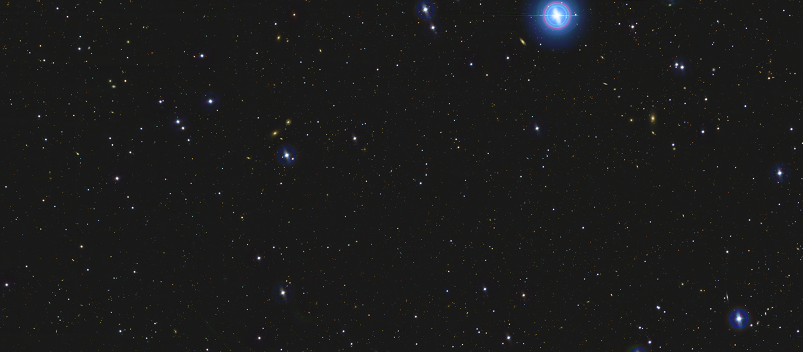Astrofísica
Comprensión de la formación de las galaxias y sus componentes, desde los cúmulos globulares hasta los agujeros negros supermasivos

Crédito: colaboración J-PAS
Esta línea de investigación se centra en diversos aspectos de la formación y evolución de las galaxias. Para ellos se utilizan tanto simulaciones como observaciones para comprender cómo se forman las galaxias y cómo evolucionan sus propiedades a lo largo de la evolución cosmológica del Universo.
Temas específicos
- Desarrollo de modelos teóricos para estudiar la formación, el crecimiento y las fusiones de agujeros negros masivos dentro de sus galaxias anfitrionas.
- Utilización de sondeos de campo amplio en el estudio de galaxias activas a través del corrimiento al rojo.
- Utilización de simulaciones hidrodinámicas para comprender la formación de estructuras barradas dentro de las galaxias y su papel en la conformación de las propiedades globales de las galaxias anfitrionas.
- Estudio de las propiedades de los cúmulos globulares.
Publicaciones relacionadas
-
 1
TREASUREHUNT: transients and variability discovered with HST in the JWST north eliptic pole time-domain field
1
TREASUREHUNT: transients and variability discovered with HST in the JWST north eliptic pole time-domain field
R. O'Brien, R. A. Jansen, N. A. Grogin, S. H. Cohen, B. M. Smith, R. M. Silver, W. P. Maksym III, R. A. Windhorst, T. Carleton, A. M. Koekemoer, N. P. Hathi, C. N. A. Willmer, B. L. Frye, M. Alpaslan, M. L. N. Ashby, T. A. Ashcraft, S. Bonoli, W. Brisken, N. Cappelluti, F. Civano, et al.
Astrophys. J. Suppl. Ser. 272, 1 (2024). -
 2
Stochastic wave dark matter with Fermi-LAT γ-ray pulsar timing array
2
Stochastic wave dark matter with Fermi-LAT γ-ray pulsar timing array
Hoang Nhan Luu , T. Liu, J. Ren, T. Broadhurst, R. Yang, J. -S. Wang, and Z. Xie
Astrophys. J. Lett. 963, 2 (2024). -
 3
A magnified compact galaxy at redshift 9.51 with strong nebular emissionlines
3
A magnified compact galaxy at redshift 9.51 with strong nebular emissionlines
H. Williams, P. L. Kelly, W. Chen, G. Brammer, A. Zitrin, T. Treu, C. Scarlata, A. M. Koekemoer, M. Oguri, Y. -H. Lin, J. M. Diego, M. Nonino, J. Hjorth, D. Langeroodi, T. Broadhurst, N. Rogers, I. Perez-Fournon, R. J. Foley, S. Jha, V. Filippenko, et al.
Science 380, 416 (2023). -
 4
Einstein rings modulated by wavelike dark matter from anomalies ingravitationally lensed images
4
Einstein rings modulated by wavelike dark matter from anomalies ingravitationally lensed images
A. Amruth, T. Broadhurst, J. Lim, M. Oguri, G. F. F. Smoot, J. M. M. Diego, E. Leung, R. Emami, J. Li, T. Chiueh, H. -Y. Schive, M. C. H. Yeung, and S. K. Li
Nat. Astron. 7, 736 (2023). -
 5
Overmassive black holes in dwarf galaxies out to z similar to 0.9 in the VIPERS survey
5
Overmassive black holes in dwarf galaxies out to z similar to 0.9 in the VIPERS survey
M. Mezcua, M. Siudek, H. Suh, R. Valiante, D. Spinoso, and S. Bonoli
Astrophys. J. Lett. 943, 1 (2023). -
 6
Subhalo abundance matching through the lens of a hydrodynamicalsimulation
6
Subhalo abundance matching through the lens of a hydrodynamicalsimulation
G. Favole, A. D. Montero-Dorta, M. C. Artale, S. Contreras, I. Zehavi, and X. Xu
Mon. Not. Roy. Astron. Soc. 509, 1614 (2022). -
 7
Shock cooling of a red-supergiant supernova at redshift 3 in lensedimages
7
Shock cooling of a red-supergiant supernova at redshift 3 in lensedimages
W. Chen, P. L. Kelly, M. Oguri, T. J. Broadhurst, J. M. Diego, N. Emami, V. Filippenko, T. L. Treu, and A. Zitrin
Nature 611, 256 (2022). -
 8
J-PLUS: Spectral evolution of white dwarfs by PDF analysis
8
J-PLUS: Spectral evolution of white dwarfs by PDF analysis
C. Lopez-Sanjuan, P. -E. Tremblay, A. Ederoclite, H. V. Ramio, J. M. Carrasco, J. Varela, A. J. Cenarro, A. Marin-Franch, T. Civera, S. Daflon, B. T. Gansicke, N. P. G. Fusillo, F. M. Jimenez-Esteban, J. Alcaniz, R. E. Angulo, D. Cristobal-Hornillos, R. A. Dupke, C. Hernandez-Monteagudo, M. Moles, and J. Sodre, et al.
Astron. Astrophys. 658, (2022). -
 9
A highly magnified star at redshift 6.2
9
A highly magnified star at redshift 6.2
B. Welch, D. Coe, J. M. Diego, A. Zitrin, E. Zackrisson, P. Dimauro, Y. Jimenez-Teja, P. Kelly, G. Mahler, M. Oguri, F. X. Timmes, R. Windhorst, M. Florian, S. E. de Mink, R. J. Avila, J. Anderson, L. Bradley, K. Sharon, A. Vikaeus, S. McCandliss, et al.
Nature 603, 815 (2022). -
 10
J-PAS: Measuring emission lines with artificial neural networks
10
J-PAS: Measuring emission lines with artificial neural networks
G. Martinez-Solaeche, R. M. Gonzalez Delgado, R. Garcia-Benito, A. de Amorim, E. Perez, J. E. Rodriguez-Martin, L. A. Diaz-Garcia, R. Cid Fernandes, C. Lopez-Sanjuan, S. Bonoli, A. J. Cenarro, R. A. Dupke, A. Marin-Franch, J. Varela, H. Vazquez Ramio, L. R. Abramo, D. Cristobal-Hornillos, M. Moles, J. Alcaniz, P. O. Baqui, et al.
Astron. Astrophys. 647, (2021).
